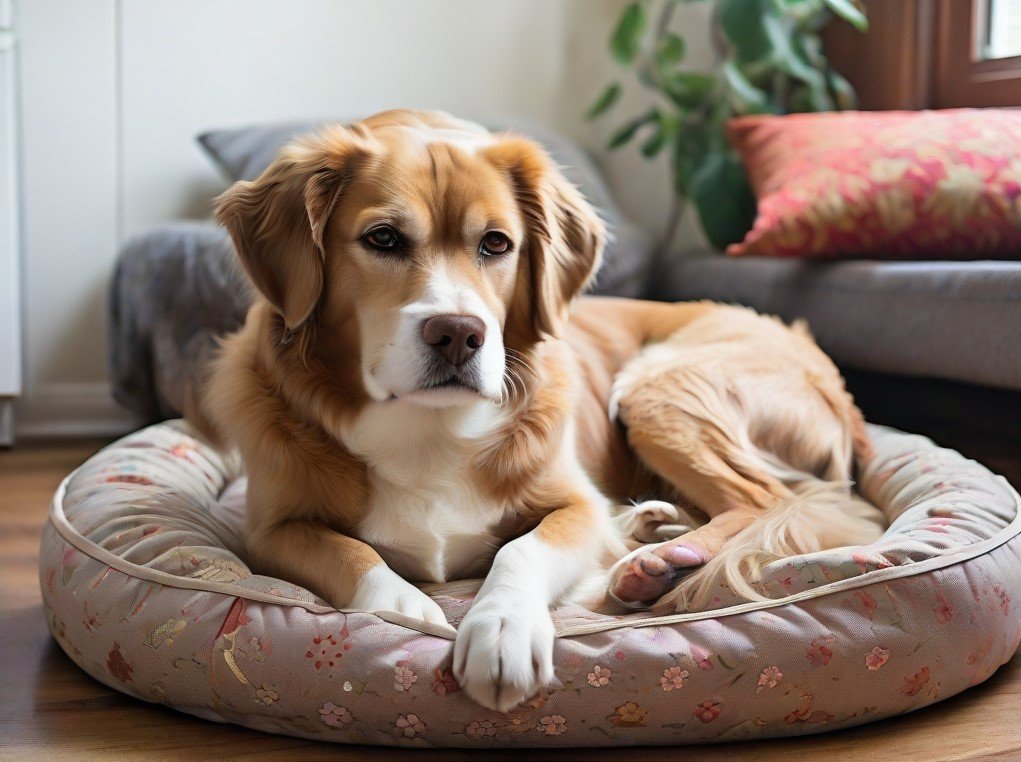If you have a dog, you might worry about bed bugs. The good news is that while bed bugs can bite dogs, they don’t carry diseases, so your furry friend is not at serious risk from these pests. Understanding how bed bugs behave can help you keep your dog safe and comfortable.
Bed bugs prefer to bite humans, but in larger infestations, they might target dogs as well. The bites can cause itching and discomfort, similar to flea bites. Knowing the signs of bites on your pet and how to manage an infestation is important for keeping your home and pets healthy.
In this article, you’ll find useful information about bed bugs and dogs, including how to recognise bites, treat them, and prevent bed bugs from becoming a problem in your home. Your dog’s comfort is a priority, and being informed can make all the difference.
Understanding Bed Bugs
Bed bugs are small, pesky insects that can cause discomfort to both humans and pets, like dogs. Learning about their characteristics, preferred habitats, and life cycle can help you understand how to deal with an infestation.
Characteristics of Bed Bugs
Bed bugs are flat, oval-shaped insects that measure about 4-5 mm long. Their bodies are brownish-red and can easily hide in small spaces. They do not have wings but are agile crawlers. Bed bugs are nocturnal feeders, meaning they come out mostly at night to bite. They are attracted to warmth and carbon dioxide, making sleeping humans and animals prime targets. While they prefer human blood, they will bite dogs if necessary.
Common Habitats
Bed bugs thrive in places where people or pets sleep, such as homes, hotels, and shelters. They often hide in mattress seams, bed frames, and furniture, but can also be found in luggage or clothing. Any damp or cluttered area can become a hiding spot for them. It’s important to regularly check areas where your dog sleeps to catch potential infestations early. Keeping your living environment clean can help reduce the chance of getting bed bugs.
Life Cycle and Reproduction
Bed bugs go through several stages in their life cycle: egg, nymph, and adult. A female can lay between 1 to 5 eggs per day, leading to rapid population growth. The tiny, white eggs hatch in about 6 to 10 days. Newly hatched nymphs require a blood meal to grow. Within a few weeks, these nymphs can become adults, which can lay more eggs. Understanding this life cycle can help you take effective action against bed bugs before they become a bigger issue.
Bed Bugs and Pets
Bed bugs can impact your pets, especially dogs. It’s essential to know the risks and understand how dogs can serve as hosts for these pests.
Risks to Dogs
While bed bugs prefer to bite humans, they can bite dogs if they are present in large numbers. The bites can lead to itchy welts on your dog’s skin, causing discomfort.
Common signs of bed bug bites on dogs include:
- Red, itchy spots
- Scratching or biting at the skin
- Restlessness
Unlike fleas, bed bugs do not transmit diseases, but they can cause allergic reactions in some pets. If your dog shows signs of irritation or excessive itching, consider checking for bed bugs as a potential cause.
Dogs as Hosts
Dogs can become hosts for bed bugs, especially when they come into contact with infested areas. This may happen if your pet sleeps on bedding, rugs, or furniture that has bed bugs.
To minimise the risk, regularly inspect your dog’s bedding and surrounding areas.
Tips for prevention include:
- Wash your dog’s bedding frequently in hot water.
- Vacuum areas where your dog rests, including furniture and carpets.
- Monitor for signs of bed bugs during travel or after visiting new places.
Being proactive helps protect your furry friend from bites and discomfort.
Identifying Bed Bug Bites
Identifying bed bug bites on dogs is essential for their comfort and health. These bites can cause irritation and discomfort. Knowing what to look for can help you take action quickly.
Signs of Bed Bug Bites on Dogs
Bed bug bites on dogs typically appear as small, red bumps. You might notice them on areas with less fur, such as the belly and limbs. These bites can be mistaken for other insect bites, so it’s crucial to pay attention to their location and appearance.
Look for dark spots around your dog’s bedding. These may be remnants of dried blood or bed bug waste. Shed exoskeletons can also indicate an infestation. If your dog frequents areas known for bed bugs, such as hotels or borrowed pet beds, keep a close eye out for these signs.
Symptoms to Watch For
If your dog has been bitten, you may see signs like scratching, biting, or licking at the affected areas. This behaviour can indicate they are feeling itchy or uncomfortable due to the bites. You should also watch for irritability or changes in behaviour, as these can signal that your pet is unwell.
Severe reactions may include swelling or redness around the bites. If your dog is scratching excessively, this can lead to secondary infections. Always consult your vet if you notice these symptoms to ensure your dog receives the proper care.
Prevention and Safe Guards
Keeping your dog safe from bed bugs requires a few simple steps. You can take proactive measures to protect your furry friend and be vigilant about detecting these pests in your home.
Protecting Your Dog
To protect your dog from bed bugs, keep their sleeping area clean. Wash your dog’s bedding regularly in hot water and dry it on a hot cycle. This helps eliminate any hidden bugs or eggs.
You should also limit your dog’s access to areas like bedrooms or places where bed bugs might be more common. If you travel, check your dog’s bed and carrier for signs of bed bugs before bringing them into your home.
Using protective covers on your dog’s bed can also help. These covers are designed to prevent bed bugs from entering.
Bed Bug Detection
Detecting bed bugs early can save you a lot of trouble. Look for unusual signs like bites on your dog or itchy skin. Check for small, reddish stains on bedding or your dog’s fur.
You can also use traps or monitors to help catch any stray bugs. Place these traps in areas where your dog sleeps or spends time.
Regular inspections of your home can make a big difference. Pay attention to cracks and crevices where bed bugs might hide. Remember, catching them early means your dog stays happy and healthy.
Treatment Options
If your dog has been bitten by bed bugs, there are immediate actions you can take to relieve discomfort. It’s also a good idea to know when to seek professional help for your furry friend. Below are the key options to consider.
First Aid for Bites
Start with some simple first aid steps. First, clean the bite area gently with mild soap and warm water. This helps remove any irritants. After cleaning, you can apply a cold compress to reduce swelling and soothe itching.
Avoid using human creams like hydrocortisone unless directed by a vet. You can use a pet-safe anti-itch lotion if your dog is really uncomfortable.
Monitor your dog for signs of infection, such as redness or discharge, and watch for any unusual behaviour, like excessive scratching or chewing at the site. Keep your dog from scratching the bites, as this can make things worse.
Consulting a Veterinarian
If your dog’s bites seem severe, or if they develop signs of an allergic reaction, consult your vet. Symptoms may include severe swelling, difficulty breathing, or excessive lethargy.
Your veterinarian may recommend medications. These could include antihistamines for allergies or steroids to reduce inflammation. In some cases, they might offer a more potent treatment for any infections.
Always bring up any concerns you’ve noticed, like changes in behaviour or appetite. A vet can provide tailored advice and treatment based on your dog’s specific needs.
Cleaning and Control
Keeping your home clean is essential in preventing and controlling bed bug infestations. You can start with some effective cleaning strategies, followed by considering professional extermination if the problem persists.
Home Cleaning Strategies
To combat bed bugs, thorough cleaning is key. Start by washing all bedding, linens, and pet items in hot water. This helps to kill any bed bugs or eggs present.
- Vacuum regularly: Focus on areas like carpets, rugs, and upholstered furniture. Pay special attention to corners and crevices where bed bugs may hide.
- Seal or dispose of clutter: Reducing clutter makes it harder for bed bugs to find hiding spots. Use sealed bags for items that you cannot wash.
After vacuuming, dispose of the vacuum bag outside your home to prevent bed bugs from escaping back into the area. Don’t forget to inspect furniture, baseboards, and even behind wall hangings.
Professional Extermination
If your cleaning efforts do not eliminate the problem, it may be time to consult a professional. Pest control experts use various methods to effectively tackle bed bug infestations.
- Chemical treatments: They often apply specialised insecticides that target bed bugs while being safe for pets.
- Heat treatment: This involves raising the temperature of a room to levels that are lethal to bed bugs, ensuring all stages of their lifecycle are eliminated.
You might choose to seek a pest control professional who understands your concerns about your dog’s safety during the treatment process. By working with experts, you can create a safer environment for both you and your furry friend.
Monitoring and Maintenance
Keeping an eye on your dog and their environment is key to preventing and addressing bed bug issues. Regular checks and long-term solutions are essential to ensure your pet remains comfortable and healthy.
Regular Checks
Regular checks can help you catch any signs of bed bugs early. Look for scratching, redness, or small red bumps on your dog’s skin. These may indicate bites, so take note if you see these symptoms.
Inspect your dog’s bedding and resting areas frequently. Bed bugs often gather near where your pet sleeps. Consider using a flashlight to check for any small brown spots or the bugs themselves.
Additionally, it’s wise to check for signs in your home. Look for their droppings or shed skins in places like mattresses, furniture, and carpets. If you notice anything unusual, take action immediately.
Long-Term Solutions
For long-term peace of mind, take preventive measures. Start by keeping your dog’s area clean. Regularly wash and vacuum dog bedding and play areas. Use a washing machine for bedding and ensure it’s dried on high heat, which can kill any hidden bugs.
It’s also helpful to create a designated space for your pet that is easy to clean. Avoid clutter, as it can provide hiding spots for bed bugs.
Consider using mattress and pillow encasements that are bed bug-proof. These barriers can help protect your home environment and your pets from bites. If you suspect a larger infestation, consult pest control professionals for safe and effective removal strategies.

